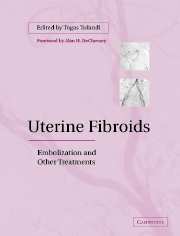Book contents
- Frontmatter
- Contents
- Contributors
- Preface
- Foreword
- 1 Uterine fibroids: epidemiology and an overview
- 2 Histopathology of uterine leiomyomas
- 3 Imaging of uterine leiomyomas
- 4 Abdominal myomectomy
- 5 Laparoscopic managment of uterine myoma
- 6 Hysteroscopic myomectomy
- 7 Myomas in pregnancy
- 8 Expectant and medical management of uterine fibroids
- 9 Hysterectomy for uterine fibroid
- 10 History of embolization of uterine myoma
- 11 Uterine artery embolization – vascular anatomic considerations and procedure techniques
- 12 Pain management during and after uterine artery embolization
- 13 Patient selection, indications and contraindications
- 14 Results of uterine artery embolization
- 15 Side effects and complications of embolization
- 16 Reproductive function after uterine artery embolization
- 17 Reasons and prevention of embolization failure
- 18 Future of embolization and other therapies from gynecologic perspectives
- 19 The future of fibroid embolotherapy: a radiological perspective
- Index
- Plate section
13 - Patient selection, indications and contraindications
Published online by Cambridge University Press: 10 November 2010
- Frontmatter
- Contents
- Contributors
- Preface
- Foreword
- 1 Uterine fibroids: epidemiology and an overview
- 2 Histopathology of uterine leiomyomas
- 3 Imaging of uterine leiomyomas
- 4 Abdominal myomectomy
- 5 Laparoscopic managment of uterine myoma
- 6 Hysteroscopic myomectomy
- 7 Myomas in pregnancy
- 8 Expectant and medical management of uterine fibroids
- 9 Hysterectomy for uterine fibroid
- 10 History of embolization of uterine myoma
- 11 Uterine artery embolization – vascular anatomic considerations and procedure techniques
- 12 Pain management during and after uterine artery embolization
- 13 Patient selection, indications and contraindications
- 14 Results of uterine artery embolization
- 15 Side effects and complications of embolization
- 16 Reproductive function after uterine artery embolization
- 17 Reasons and prevention of embolization failure
- 18 Future of embolization and other therapies from gynecologic perspectives
- 19 The future of fibroid embolotherapy: a radiological perspective
- Index
- Plate section
Summary
One of the great dilemmas in the utilization of uterine artery embolization (UAE) in the management of fibroids has been the issue of appropriate patient selection. Up to the present time, no well-defined list of indications has been developed. Since this treatment has such a dramatic impact on fibroids, it may be assumed that any woman with symptomatic fibroids is a candidate for this procedure. It was this kind of thinking that resulted in the liberal, routine use of hysterectomy by some.
In viewing the topic of patient selection, a key factor to keep in mind is the role of the patient. It is not sufficient to weigh only the medical indications and contraindications. Especially when the female reproductive organs are involved, the wishes and aspirations of the woman are paramount. In that regard, not only the physician's desire to avoid the hazards of surgery but also the desire of women to avoid uterine surgery has influenced patient selection from the outset (Table 13.1).
More ideal candidates would be the group of women for whom UAE can solve therapeutic problems heretofore unsolvable or provide a better solution (Table 13.2). Patients with substantial health problems such as morbid obesity, diabetes, hypertension, etc, constitute one obvious group. These patients can be very poor candidates for anesthesia and major surgery whereas they pose no contraindication to embolotherapy.
- Type
- Chapter
- Information
- Uterine FibroidsEmbolization and other Treatments, pp. 97 - 100Publisher: Cambridge University PressPrint publication year: 2003

